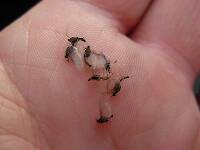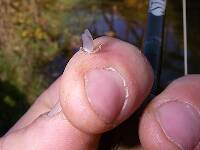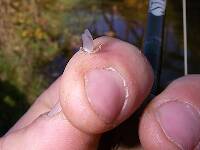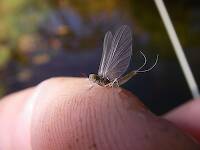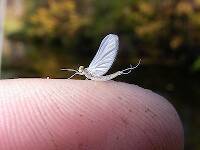
Salmonflies
Pteronarcys californica
The giant Salmonflies of the Western mountains are legendary for their proclivity to elicit consistent dry-fly action and ferocious strikes.
Featured on the forum

This one seems to tentatively key to Holocentropus, although I can't make out the anal spines in Couplet 7 of the Key to Genera of Polycentropodidae Larvae nor the dark bands in Couplet 4 of the Key to Genera of Polycentropodidae Larvae, making me wonder if I went wrong somewhere in keying it out. I don't see where that could have happened, though. It might also be that it's a very immature larva and doesn't possess all the identifying characteristics in the key yet. If Holocentropus is correct, then Holocentropus flavus and Holocentropus interruptus are the two likely possibilities based on range, but I was not able to find a description of their larvae.

Troutnut is a project started in 2003 by salmonid ecologist Jason "Troutnut" Neuswanger to help anglers and
fly tyers unabashedly embrace the entomological side of the sport. Learn more about Troutnut or
support the project for an enhanced experience here.
Martinlf on May 1, 2009May 1st, 2009, 1:53 pm EDT
I don't have a photo, but fishing a central PA stream yesterday I encountered a hatch of size 20 olives late afternoon into early evening. Would anyone out there hazard a guess as to the species given the time of day and time of year?
"He spread them a yard and a half. 'And every one that got away is this big.'"
--Fred Chappell
--Fred Chappell
Taxon on May 1, 2009May 1st, 2009, 3:57 pm EDT
Louis-
My guess would be Acentrella turbida (formerly classified as Pseudocloeon carolina among others), and an early-May late-afternoon/evening emerger, which would be of the size you describe.
My guess would be Acentrella turbida (formerly classified as Pseudocloeon carolina among others), and an early-May late-afternoon/evening emerger, which would be of the size you describe.
Konchu on May 2, 2009May 2nd, 2009, 5:00 am EDT
I agree. At least around here, the Acentrella have been thick this spring. The other possibility are some Plauditus spp. These also were included in Pseudocloeon at one time. The biggest visual difference between the two is the color of the abdomen: brown in Acentrella and whitish in Plauditus. The nymphs look alot a like, too: they both are two-tailed minnow-like forms, but the plauditus might have a stripe in the middle of the body and tails.
Martinlf on May 3, 2009May 3rd, 2009, 5:36 pm EDT
Thank you, gentlemen.
"He spread them a yard and a half. 'And every one that got away is this big.'"
--Fred Chappell
--Fred Chappell
Quick Reply
Related Discussions
Topic
Replies
Last Reply
24
Jul 21, 2011
by Entoman
by Entoman
1
Apr 18, 2007
by Troutnut
by Troutnut





